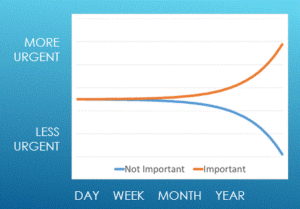 I have followed Cal Newport for several years now. He earned a Ph.D. in computer science at MIT and is now a tenured professor at Georgetown. He was doing his doctoral work at the same time I was and seemed to have good advice on how to go about earning a degree without going completely insane. He has since published a pair of great books: So Good They Can’t Ignore You and Deep Work: Rules for Focused Success in a Distracted World. I’ll post on So Good later, but my thinking about attention management is closely tied to his notion of deep work, so I wanted to cover the topic and the book for my readers’ reference.
I have followed Cal Newport for several years now. He earned a Ph.D. in computer science at MIT and is now a tenured professor at Georgetown. He was doing his doctoral work at the same time I was and seemed to have good advice on how to go about earning a degree without going completely insane. He has since published a pair of great books: So Good They Can’t Ignore You and Deep Work: Rules for Focused Success in a Distracted World. I’ll post on So Good later, but my thinking about attention management is closely tied to his notion of deep work, so I wanted to cover the topic and the book for my readers’ reference.
Deep Work explains one way in which work is changing. With the rise of knowledge work, Newport sees a division of labor among knowledge workers. Much of knowledge work is what he calls shallow work. Shallow work is the administrative side of knowledge work, including managing email and other communication, organizing, editing, and non-directed surfing on the internet.
In contrast, deep work is the work knowledge workers produce when they are at their best. This is the demanding problem solving, strategizing, proving-new-things kind of work that produces value. It is valuable in the economy because it is hard to replicate and to the worker because it improves the worker’s skills. Deep work occurs in relatively isolated extended chunks of time. We work to get our heads around the entire problem, chapter, or situation and, when we finally do, make progress on the really difficult part of our work. It is the kind of work that, if interrupted, takes a significant amount of time to restart because we have to regain the mental state that was lost due to the interruption.
Newport argues that, in order to produce value, we need to spend more time in deep work.
The problem is that social and technological forces move us toward shallow work. Three prevailing, but questionable, ideas push us toward shallow work: We can multitask and still produce our best work (we can’t). We have to be available for communication at all times (probably not). Social sites and most of the internet produce valuable information (they don’t usually). Newport acknowledges that exceptions exist, but generally argues that these three ideas are not true. Finally, he notes another force toward shallow work – our brains favor shallow work because it is cognitively easier, requiring less mental effort and concentration.
Newport argues that deep work is valuable, increasingly rare, and more meaningful than shallow work.
The value of deep work is based on two of its properties: it allows us to quickly master hard things and it allows us to produce more output of higher quality. It is increasingly important to do these things as we face cognitive computing and the automation of manual and some craft work.
The rarity of deep work is based on cultural arguments. 1) Workplaces are trending toward open offices, instant messaging use, and increased insistence on social media presence, each of which hampers deep work efforts. 2) Particularly in large organizations, it is difficult to directly measure the contribution of deep work; this supports the cult of busyness, in which visible, but shallow, contributions are often rewarded. 3) The cult of the internet believes that something is irrelevant if it is not visible.
In support of the meaningfulness of deep work, Newport makes three different arguments, backed by research.
- Neurology – Managing our attention through engaging in deep work keeps us focused away from the traps (e.g. the comparison trap) that tend to make us discontent.
- Psychology – Our minds prefer to be engaged in deep work; we like to be challenged and get bored quickly with routine tasks and what currently passes for leisure.
- Philosophy – Deep work promotes a sense of craftsmanship (the technical version is elegance) which endows our work with meaning far beyond simply earning money.
Newport finds that, in order to engage in deep work, we need to be in relatively distraction free environments. He cites many examples of authors, academics, and scientists who produced world-changing work, in part, because they removed themselves from distraction rich environments. In part 2, Newport lays out four rules that help us determine what is deep work in our context and help us focus on it. This is the point where my work connects to his – attention management. Much of part 2 relates to thinking on this site.
Rule 1 covers methods of entering into deep work periods. We need to defend our attention while we are trying to work deeply.
Rule 2 shows ways that we can improve our deep work stamina. We need to train ourselves to focus and concentrate, particularly since if we have been engaging in shallow work for years.
Rule 3 is about our communication tools. We need to be more selective about what we engage with on the internet through recognizing that not all tools are of equal value.
Rule 4 considers removing shallow work. We need to identify shallow work in our lives and work to eliminate it; Newport gives a couple dozen tips and practices to try in our work lives.
The book concludes with a short description of how development and application of deep work principles have fueled Newport’s quite successful academic career to date. That evidence alone should be sufficient motivation to bring some deep work into our lives.
Cal continues to elaborate on these ideas on his blog. In addition, Brett McKay interviewed Cal on the Art of Manliness podcast, here.
 I have followed Cal Newport for several years now. He earned a Ph.D. in computer science at MIT and is now a tenured professor at Georgetown. He was doing his doctoral work at the same time I was and seemed to have good advice on how to go about earning a degree without going completely insane. He has since published a pair of great books: So Good They Can’t Ignore You and
I have followed Cal Newport for several years now. He earned a Ph.D. in computer science at MIT and is now a tenured professor at Georgetown. He was doing his doctoral work at the same time I was and seemed to have good advice on how to go about earning a degree without going completely insane. He has since published a pair of great books: So Good They Can’t Ignore You and 